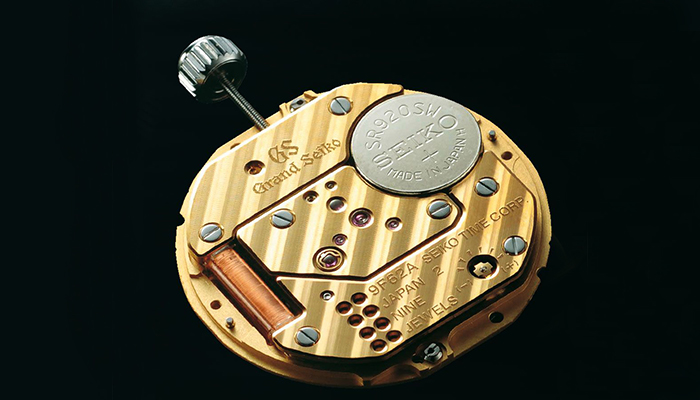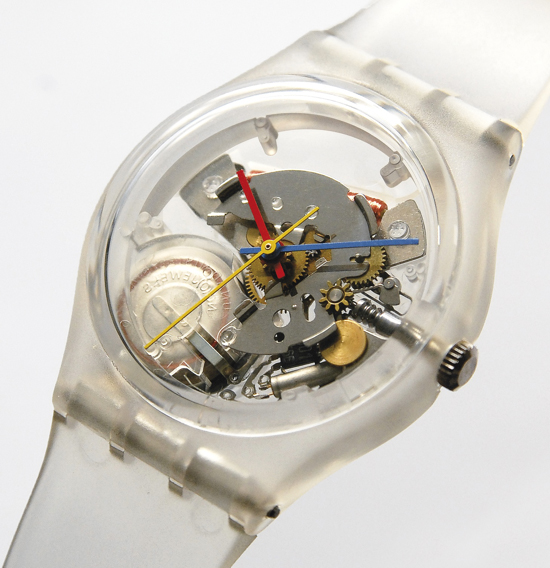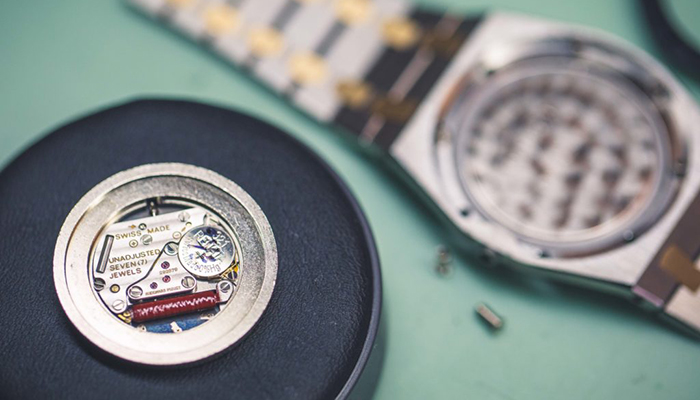What is a Swiss Quartz Movement?
A “quartz” watch is one that is powered by a quartz movement, complete with electronic circuit board, synthetic quartz crystal and battery, as opposed to mechanical moving gears, wheels and other parts. Many countries today produce quartz movements, including Switzerland. Here we take a look at what a Swiss quartz movement is.
All quartz watches basically relay power similarly, with a button-style cell battery that charges (or relays an electrical current) to a synthetic quartz crystal oscillator. Most quartz movements, whose second hands move in individual “ticks,” beat at a frequency of 32,768 oscillations per second, although today there are also very high precision (VHP) calibers on the market that vibrate at even faster oscillations per minute. The vibrating crystal drives a motor that moves the hands at a constant rate and powers any additional functions such as dual time or a chronograph. Generally, quartz watches are highly desirable for their precision and accuracy and because they run constantly (until the battery dies) and don’t need to be regularly set. Today’s quartz watches typically house batteries with two- to five-year life spans.
History of the Swiss Quartz Watch
Throughout the 1970s, Swiss mechanical industry lost major market share to the newfangled quartz technology and, more specifically, to the Japanese watch brand Seiko. Quartz watches more attractive to the mass market: they were easy to use and, unlike traditional mechanical watches, didn’t require winding or servicing. The Swiss watch industry, which had been built on hand-craftsmanship and keen mechanics, lagged in embracing the quartz concept and did not pursue the serial production of quartz watches with the same fervor as the Japanese and American watch companies.

Grand Seiko Japanese Quartz Movement
In 1977, as sales of quartz watches soared, sales of mechanical Swiss watches plummeted. The Swiss watch industry was in dire straights, and, by 1978, were in the throes of what is today referred to as the Quartz Crisis. Traditional Swiss watch brands began going out of business, and, over the ensuing half a dozen years, the Swiss lost a host of long-standing mechanical watch brands.
Finally, under the direction of Nicholas G. Hayek, Sr., who was brought in to revamp and hopefully save the Swiss watch industry, the ETA SA movement company was formed to focus on quartz production. However, the truly big break for the Swiss watch industry came in 1983 when ETA developed an incredibly inexpensive Swiss quartz movement that was housed in a plastic watch, called Swatch, which sold for $35. The watch not only took the world by surprise, but also led the charge for the Swiss industry to regain its foothold. Within two years, Swiss watch sales were on the upswing and most Swiss brands were offering quartz watches, alongside their mechanical pieces.

“The Original Jelly Fish” (ref. GK100 SP, early 1983) by Swatch, Image via First Versions
Swiss Quartz Movements vs. Japanese Quartz Movements
Today, the Swiss have a relatively healthy quartz watch business, with many brands crating watches powered by Swiss Quartz movements. In broad terms, the only real differentiation between a Swiss Quartz movement and a Japanese (or German, French, Asian, Russian or other country’s quartz movements) quartz movement is the country of origin.
Much like the requirements most countries have in place in order to designate their products as officially “Made In” that country, the Swiss have definitive requirements about what constitutes a Swiss-made watch and a Swiss movement.

Image via Crown & Caliber
To be deemed a Swiss movement, the entire caliber must be assembled in a Swiss-based factory and must be inspected in Switzerland. Additionally, the Swiss manufactured components must account for at least 60% of the total value before assembly. There are a variety of “stamps” that flag a watch as having a Swiss movement, including Swiss quartz, Swiss Movement (MVMT) or Swiss.
Today, certain top watchmaking brands build their own Swiss quartz movements to meet their brand’s strict quality standards. Additionally, there are host of Swiss quartz movement manufacturers, such as ETA and Ronda, among others, that sell quartz movements to individual brands.
To learn more about the difference between quartz and mechanical watches, particularly as it comes to caring for each, check out our post on the topic here.







